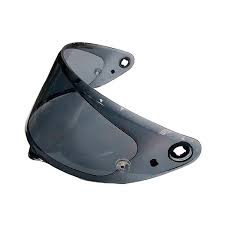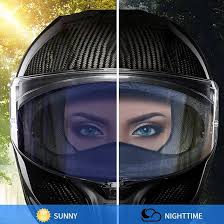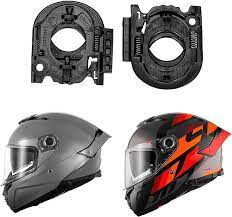
HJC Helmet Visor: Enhancing Safety and Style on the Road
When it comes to riding motorcycles, safety should always be a top priority. One crucial element in ensuring rider safety is a reliable and high-quality helmet. Among the leading brands in the market, HJC stands out for its commitment to producing top-of-the-line helmets with innovative features. One such feature that sets HJC helmets apart is their visor system.
The HJC helmet visor is designed with both functionality and style in mind. It serves as a protective shield against various elements that riders encounter on the road, such as wind, debris, and UV rays. The visor’s primary purpose is to provide clear vision while riding, allowing riders to focus on the road ahead without distractions.
HJC visors are crafted using advanced materials that offer exceptional clarity and durability. They are often made from polycarbonate or other impact-resistant materials to ensure maximum protection in case of accidents or impacts. These visors undergo rigorous testing processes to meet industry safety standards, providing riders with peace of mind knowing they have reliable protection on their heads.
One notable feature of HJC helmet visors is their quick-release mechanism. This allows riders to easily replace or remove the visor without any hassle, making it convenient for cleaning or switching between different tinted options based on weather conditions. This user-friendly system ensures that riders can adapt quickly to changing light conditions for optimal visibility.
In addition to its functional aspects, HJC also pays attention to style when designing their helmet visors. They offer a wide range of options, including clear, tinted, mirrored, and iridium-coated visors that not only enhance visual comfort but also add a touch of personal style to your overall look while riding.
Furthermore, HJC understands the importance of proper ventilation during rides. Many of their helmet models come equipped with adjustable vents strategically placed around the helmet shell. These vents work in conjunction with the visor system, allowing riders to control airflow and prevent fogging, especially during challenging weather conditions.
It is worth mentioning that HJC helmet visors are designed to fit specific helmet models, ensuring a precise and secure fit. This compatibility ensures that the visor stays in place even during high-speed rides or strong winds, providing optimal protection and stability.
When it comes to rider safety and comfort, investing in a reliable helmet with a quality visor is essential. HJC helmets have built a solid reputation over the years for their commitment to producing top-notch products. Their helmet visors are no exception, offering riders both safety and style on the road.
Whether you’re a seasoned rider or just starting your motorcycle journey, consider exploring the range of HJC helmets and their accompanying visors. With their innovative features, durability, and attention to detail, HJC helmets provide riders with the confidence they need to enjoy every ride while keeping safety at the forefront. Ride safe, ride stylishly with an HJC helmet visor!
6 Essential Tips for Maintaining Your HJC Helmet Visor
- Cleaning
- Soft Cloth
- Water Temperature
- Drying
- Storage
- Replacement
Cleaning
Cleaning Your HJC Helmet Visor: A Clear View for a Safer Ride
Keeping your HJC helmet visor clean is an essential part of maintaining optimal visibility and safety while riding. Over time, dust, insects, and other debris can accumulate on the visor, impairing your vision and potentially causing distractions. Fortunately, cleaning your HJC helmet visor is a simple task that can be done with a few easy steps.
Firstly, start by removing the visor from the helmet. Most HJC helmets have a quick-release mechanism that allows for easy removal of the visor. Follow the manufacturer’s instructions to ensure you detach it correctly.
Once you have removed the visor, rinse it gently with lukewarm water to remove any loose dirt or debris. Avoid using hot water or harsh chemicals as they may damage the visor’s anti-scratch or anti-fog coatings. If there are stubborn stains or bugs stuck on the surface, you can use a mild soap solution or specialized helmet visor cleaner. Apply it with a soft cloth or sponge and gently wipe in circular motions to avoid scratching.
After cleaning, rinse off any residue thoroughly with clean water to ensure all traces of soap or cleaner are removed. Pat dry with a soft, lint-free cloth or allow it to air-dry naturally.
It’s important to note that when drying or wiping your HJC helmet visor, avoid using rough materials like paper towels or abrasive cloths as they can cause scratches. Opt for microfiber cloths specifically designed for cleaning delicate surfaces instead.
Once dry, inspect the visor for any remaining dirt or streaks. If needed, repeat the cleaning process until you achieve a clear and spotless surface.
To maintain its performance and longevity, it’s advisable to store your HJC helmet visor in a protective case when not in use. This will help prevent scratches and keep it free from dust and other contaminants.
Regular cleaning of your HJC helmet visor is not only crucial for maintaining clear vision but also for extending its lifespan. By following these simple cleaning steps, you can ensure that your visor remains in optimal condition, allowing you to enjoy a safe and unobstructed view during every ride.
Remember, a clean and well-maintained helmet visor is an essential part of your riding gear. So take the time to care for it properly, and you’ll be rewarded with a clear view and enhanced safety on the road.
Soft Cloth
When it comes to caring for your HJC helmet visor, one simple yet effective tip is to use a soft cloth. Cleaning your visor regularly not only helps maintain its clarity but also ensures optimal visibility while riding.
Using a soft cloth, such as a microfiber cloth or a lens cleaning cloth, is essential to prevent scratches or damage to the visor’s surface. Avoid using abrasive materials like paper towels or rough fabrics that can potentially leave marks or compromise the integrity of the visor.
To clean your HJC helmet visor, start by gently removing any loose dirt or debris with a soft brush or by rinsing it under lukewarm water. Then, dampen the soft cloth with water or a mild soapy solution and carefully wipe the visor in a gentle circular motion. Make sure to remove all traces of dirt without applying excessive pressure.
After cleaning, rinse the visor thoroughly with clean water and pat it dry with a clean, dry portion of the soft cloth. Avoid rubbing or scrubbing vigorously as this can lead to scratches. Once dry, you can use another dry portion of the cloth to gently buff the surface for added clarity.
Remember that proper care and maintenance of your HJC helmet visor not only enhances its lifespan but also contributes to your safety on the road. Regularly inspecting and cleaning your visor ensures that you have an unobstructed view while riding, allowing you to stay focused and aware of your surroundings.
By following this simple tip and using a soft cloth for cleaning, you can keep your HJC helmet visor in excellent condition for many rides to come. So grab that soft cloth and give your visor some TLC – both you and your helmet will thank you for it!
Water Temperature
When it comes to riding motorcycles, weather conditions can vary greatly. One element that riders often encounter is rain, and dealing with water on the helmet visor can be a challenge. However, HJC helmet visors are designed to handle such situations with ease.
One helpful tip for riders facing wet conditions is to adjust the water temperature when cleaning the visor. Using warm water rather than cold water can make a noticeable difference in preventing fogging or condensation on the visor.
Warm water helps to remove dirt and grime more effectively, ensuring a clear view while riding. Additionally, the slight warmth of the water helps to prevent rapid temperature changes that can lead to fogging on the visor surface.
When cleaning your HJC helmet visor, simply use lukewarm water and a mild soap or dedicated helmet cleaner. Gently wipe the surface with a soft cloth or sponge, taking care not to scratch or damage the visor. Rinse thoroughly and allow it to air dry or use a clean cloth for drying.
By adjusting the water temperature when cleaning your HJC helmet visor, you can maintain optimal visibility even in wet conditions. This small but effective tip ensures that you ride safely and confidently, regardless of the weather.
Remember, safety should always be a priority when riding motorcycles. Invest in high-quality gear like HJC helmets with their innovative visor systems to enhance your riding experience and protect yourself on every journey.
Drying
Proper Drying Techniques for Your HJC Helmet Visor
After an exhilarating ride, it’s essential to take care of your motorcycle gear, including your HJC helmet visor. Proper maintenance ensures that your visor remains in optimal condition for long-lasting use. One crucial aspect of maintenance is drying your visor correctly.
When it comes to drying your HJC helmet visor, it’s important to avoid using harsh methods or materials that may damage the surface. Here are a few tips to help you dry your visor effectively:
- Air Drying: The simplest and safest way to dry your HJC helmet visor is by air drying. After removing the visor from the helmet, gently wipe off any excess moisture with a soft cloth or towel. Then, find a clean and well-ventilated area where you can leave the visor to air dry naturally. Avoid exposing it to direct sunlight or heat sources as this may cause warping or damage.
- Microfiber Cloth: If you prefer a faster drying method, you can use a clean microfiber cloth specifically designed for delicate surfaces. Gently pat the visor with the cloth to absorb any remaining moisture. Avoid rubbing vigorously as this may scratch or damage the surface.
- Avoid Using Heat: It’s crucial to avoid using heat sources like hairdryers or heaters to speed up the drying process. Excessive heat can distort the shape of the visor and compromise its integrity.
- Store Properly: Once your HJC helmet visor is completely dry, store it in a safe place away from direct sunlight and extreme temperatures. Using a protective case or bag designed for helmet accessories can help prevent dust accumulation and potential scratches.
Remember, taking care of your HJC helmet visor not only ensures its longevity but also contributes to your overall safety on the road. Regular cleaning and proper drying techniques will keep your visor clear and free from any obstructions, allowing for optimal visibility while riding.
By following these simple tips, you can maintain the quality and performance of your HJC helmet visor for many rides to come. Enjoy the road ahead with a well-maintained and properly dried visor, knowing that you’re taking the necessary steps to protect yourself and enhance your riding experience.
Storage
Proper Storage: Keeping Your HJC Helmet Visor in Top Condition
When it comes to maintaining the longevity and performance of your HJC helmet visor, proper storage is key. Storing your visor correctly not only helps protect it from scratches and damage but also ensures that it remains in optimal condition for clear visibility on your rides.
First and foremost, always store your HJC helmet visor in a safe and secure place. Avoid leaving it lying around where it can be accidentally knocked over or stepped on. A designated storage area, such as a helmet bag or case, is highly recommended to provide adequate protection.
Before storing the visor, make sure it is clean and dry. Use a mild soap or visor cleaner specifically designed for motorcycle helmets to gently remove any dirt, bugs, or debris. Avoid using harsh chemicals or abrasive materials that could potentially scratch the surface of the visor. Once cleaned, allow the visor to air dry completely before storing.
When placing the visor in its storage bag or case, ensure that it is positioned in a way that minimizes contact with other objects. Ideally, store it separately from the helmet itself to prevent any accidental scratching during transportation or handling.
If you have multiple visors for different weather conditions or tint preferences, consider investing in a dedicated storage system that allows you to organize and protect each one individually. This will help prevent any mix-ups and ensure easy access when needed.
It’s important to note that extreme temperatures can affect the integrity of your HJC helmet visor. Avoid exposing it to direct sunlight for prolonged periods as this can cause warping or discoloration. Similarly, storing your helmet with the visor attached in extremely hot or cold environments can compromise its durability over time.
Regularly inspect your HJC helmet visor for any signs of wear and tear. If you notice significant scratches, cracks, or other damage, it may be time to replace the visor to maintain optimal safety and visibility on the road.
By following these simple storage tips, you can help prolong the lifespan of your HJC helmet visor and ensure that it continues to provide clear, unobstructed vision during your rides. Remember, proper storage is an essential part of caring for your gear and maintaining a safe and enjoyable motorcycling experience.
Replacement
HJC Helmet Visor Replacement: Keeping Your Ride Clear and Safe
Your HJC helmet visor is an essential component of your riding gear, providing protection and clarity on the road. Over time, wear and tear or unfortunate accidents may lead to the need for a replacement visor. Luckily, HJC makes the process of replacing your helmet visor quick and easy.
When it comes to replacing your HJC helmet visor, you’ll be pleased to find that HJC offers a range of options to suit your needs. Whether you prefer a clear visor for everyday rides or a tinted one for those sunny adventures, HJC has got you covered.
To begin the replacement process, ensure that you have the correct replacement visor for your specific HJC helmet model. Each helmet model has its own unique design and mounting system, so it’s important to choose the right one to ensure a perfect fit.
Once you have the replacement visor in hand, it’s time to remove the old one. Most HJC helmets feature a simple and convenient quick-release mechanism for easy removal. Follow the manufacturer’s instructions or consult their online resources for guidance on how to properly remove your current visor.
Once the old visor is removed, carefully align the new visor with the mounting points on your helmet. Take note of any tabs or connectors that need to be properly engaged before securing it in place. Gently press down until you hear a satisfying click, indicating that the visor is securely attached.
Before hitting the road with your new visor, take a moment to ensure it is correctly positioned and aligned with your line of sight. Make any necessary adjustments by gently maneuvering it until you achieve optimal visibility and comfort.
Remember, regular maintenance of your HJC helmet visor is crucial for its longevity and performance. Keep it clean by using mild soap and water or specialized cleaning solutions designed specifically for helmet visors. Avoid using abrasive materials or harsh chemicals that may damage the visor’s surface or anti-fog coatings.
Replacing your HJC helmet visor not only ensures clear vision but also contributes to your overall safety on the road. With HJC’s commitment to quality and innovation, you can trust that their replacement visors will meet the same high standards as their original ones.
So, if you find yourself in need of a new visor for your HJC helmet, don’t fret. With a little care and attention, you can easily replace it and get back to enjoying your rides with clear vision and peace of mind. Stay safe, stay stylish with an HJC helmet visor replacement!






